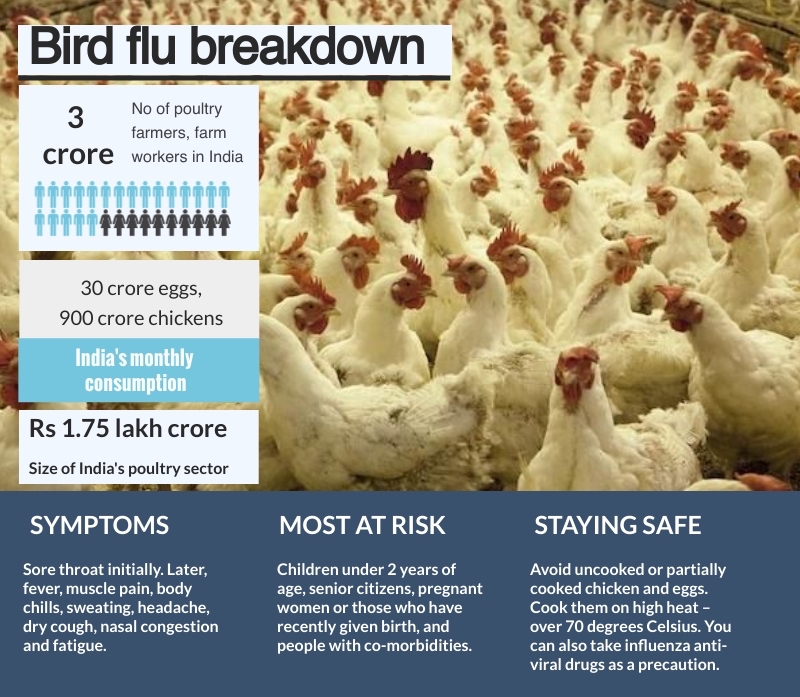Ashraf Engineer
January 16, 2021

PODCAST TRANSCRIPT
Hello and welcome to All Indians Matter. I am Ashraf Engineer.
Roughly one and a half years after India declared itself free of bird flu, we are once again in the midst of an outbreak. At least 10 states have reported thousands of bird deaths caused by the virus. Coming on the back of COVID-19, this is a worry because of its economic impact and because it can be transferred to humans in some cases.
SIGNATURE TUNE
At the time of recording this podcast, Delhi, Maharashtra, Uttarakhand, Uttar Pradesh, Kerala, Rajasthan, Madhya Pradesh, Himachal Pradesh, Haryana and Gujarat had confirmed cases of avian influenza, better known as bird flu. While no cases of human transmission had been reported, lakhs of birds had either died or been culled as a safety measure.
States and the Central Government scrambled to contain the spread of the virus with Delhi banning the import of live birds and shutting its biggest wholesale poultry market in Ghazipur. In Maharashtra’s Parbhani, about 500 km from Mumbai, 800 bird deaths were reported leading to at least 8,000 poultry birds being culled as a precautionary measure. In Kerala, tens of thousands of birds were culled after 12,000 ducks died of the virus. Haryana was the worst affected with 4 lakh bird deaths and the culling of nearly 2 lakh birds.
Chief secretaries of all states and union territories are monitoring the situation closely and tracking water bodies, bird markets, zoos, poultry farms and surrounding areas. States have been told to ensure the availability of personal protection equipment kits that are used to cull birds and dispose of carcases and bird waste.
So, what exactly is bird flu and what is its impact?
The illness is caused by an influenza Type A virus that is highly contagious among bird species. It was first discovered in 1996 in geese in China. The virus is spread by migratory birds through their droppings, infecting poultry majorly. It was in 1997 that the first case of the infection being transmitted to a human was reported.
While no human transmissions have been reported in India, you can’t rule out the possibility because the flu has many strains with H5N1, H7N9 and H9N2 being the most pathogenic and transmissible to humans. In India, it’s the H5N1 strain that is being reported.
If there are cases among humans, it will be known in the next few days but what’s certain already is the economic impact of the flu.
The outbreak directly affects more than three crore farmers and farm workers that comprise India’s poultry sector that is worth Rs 1.75 lakh crore. The prices of poultry and poultry products are plummeting not just in the affected states but also in those that are not affected. India consumes nearly 30 crore eggs and 900 crore chickens per month but the flu outbreak is discouraging consumers.
The impact of COVID-19 provides some clues as to how bird flu will hurt financially. At the start of the COVID-19 pandemic, there were rumours that the virus might be spread via birds. Almost immediately, the poultry sector lost nearly $1 billion – that’s more than Rs 7,000 crore.
Today, as birds are being culled, poultry farmers find themselves marooned again. Many states have promised compensation, but that is not even close to the losses they might suffer.
Shop owners across India reported sales shrinking between 15% and 60% depending on how badly affected their respective regions were. Share prices of poultry product companies fell too.
After the economic distress of COVID-19, India needed every industrial sector to fire on all cylinders. Poultry has been a promising industry, projected to grow 16.2% between 2019 and 2024 but that may not happen now.
But what about you? What should you watch out for and how can you stay safe?
Bird flu manifests itself through symptoms like a sore throat initially and later through fever, muscle pain, body chills, sweating, headache, dry cough, nasal congestion and fatigue. Children under 2 years of age, senior citizens, pregnant women or those who have recently given birth, and people with co-morbidities are most at risk.
You can stay safe by avoiding uncooked or partially cooked chicken and eggs. Cooking them on high heat – that is, over 70 degrees Celsius – kills the virus. You can also take influenza anti-viral drugs as a precaution.
Most importantly, there is no reason whatsoever to panic. As I said earlier, there are no human transmissions reported. The good news is that human cases of H5N1 occur occasionally, and it is difficult to transmit the infection from person to person. The bad news is, when people do get infected, the mortality rate is about 60%.
Stay safe and thank you all for listening. Please visit www.allindiansmatter.in for more columns and audio podcasts. You can follow me on Twitter at @AshrafEngineer and @AllIndiansCount. Search for the All Indians Matter page on Facebook. On Instagram, the handle is @AllIndiansMatter. Mail me at editor@www.allindiansmatter.in. Catch you again soon.






